一个古老盆地改变了世界能源格局,来看看它的风采
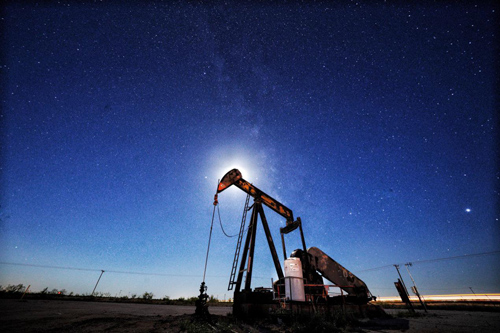
|
格里尔·布伦森一家在西得州有块45平方英里(116.55平方公里)的农场,当中镶嵌着一块郁郁葱葱的洼地,他们称之为“小坑”。 几千年前,普韦布洛人在这儿建立了石头村落。几百年前,科曼奇族印第安人如奔雷般在这片平原上纵马驰骋。如今,“小坑”内外的自然资源引来的则是相当现代化的人流。 洼地边上,在牧豆树和灌木蒿之间,隆隆作响的石油钻机就像正在发射的火箭,一个油井压裂小组正通过一台巨大、响声持续而单调的液压泵把难以计数的水和几百卡车沙土灌入地下。对布伦森一家来说,这样的场景和那些声音意味着收入——从地下2英里(3.22公里)的石头缝里挤出的石油正通过精心钻出的孔洞抽取出来,日产量可达数千桶,价值几百万美元。 |
Smack in the middle of Grier Brunson’s family’s ranch, a patch of West Texas dirt that sprawls across 45 square miles, sits a lush, green dip in the land that the family calls “the draw.” Thousands of years ago, ¬Pueblos built rocky settlements here. Hundreds of years ago, Comanches thundered on horseback across this plain. Today, the natural bounty in and around the draw is producing a rather more modern stampede. On the rim of the draw, amid the mesquite trees and the sagebrush, oil rigs loom like rockets at launch, and a team fracking a well shoots untold thousands of gallons of water and hundreds of truckloads of sand down into the earth, using huge hydraulic pumps that emit a dull, constant roar. For the Brunson family, these are the sights and sounds of money: Two miles underground, oil—thousands of barrels of it every day, worth millions of dollars—is being cracked loose from the rock and pulled up through carefully engineered holes. |
二叠纪盆地剪影

米德兰德附近钻井作业区夜间航拍。摄影师本杰明·罗伊在两个时区用了五天时间来拍摄人物、过程、地点和石油。

工人在得州米德兰德操作钻机。
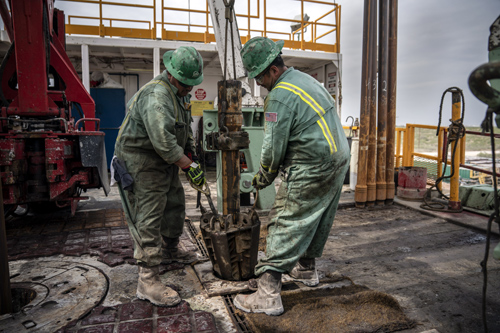
工人在得州米德兰德操作钻机。

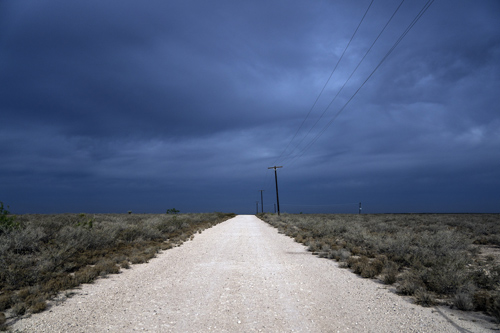
拉夫灵县的一条路。
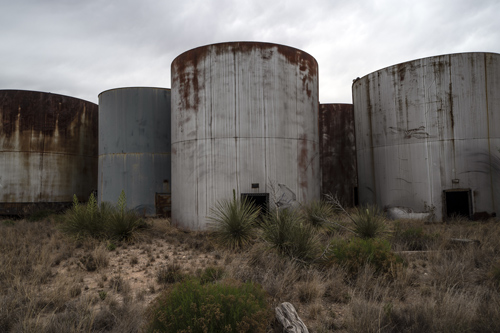
敖德萨和佩科斯之间生锈的储油罐。

得州佩科斯Pody's BBQ餐馆的石油工人。

拖车公园等待入场的名单排到了两年以后,费用约为每月2000美元。
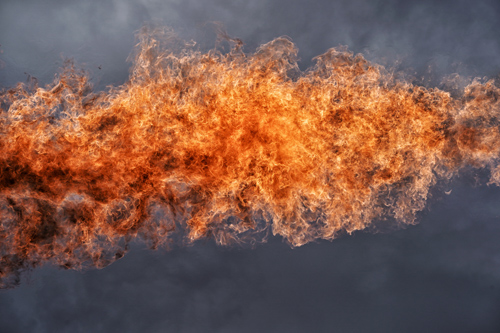
得州佩科斯附近一口油井的天然气火炬。
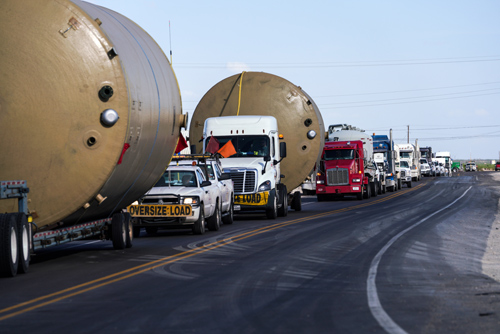
蒙通和奥拉之间的路况。卡车装着沙子,还有数千辆卡车装着水、石油、管道、泵、油罐以及油田需要的其他所有东西。
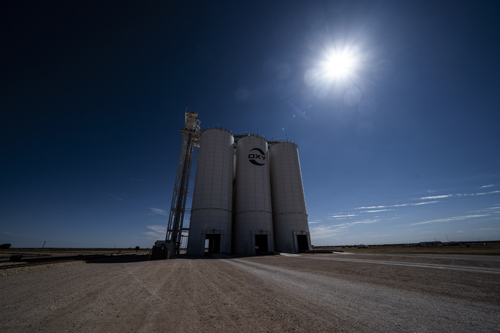
西方石油公司的沙土筒仓。该公司提供压裂用沙土。

西方石油公司油田用于压裂的沙土。
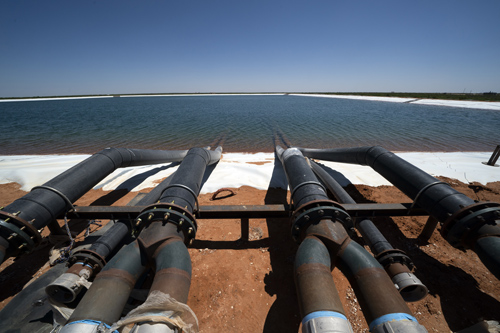
赞恩·奇勒所有土地中的一个淡水坑。
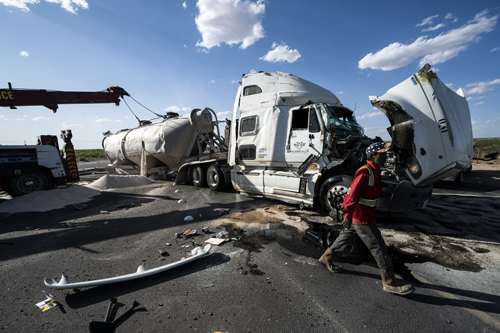
由于出现大量致死事故,285号公路被称为“死亡之路”。
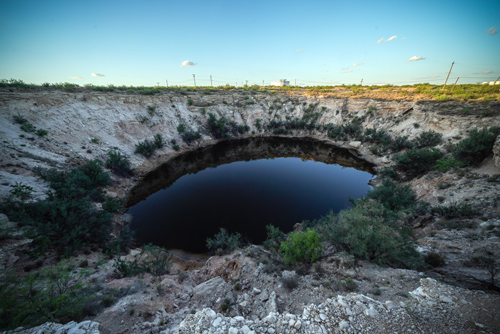
得州克米特的塌陷坑。二叠纪盆地的某些地区不光有地震,还有地陷。
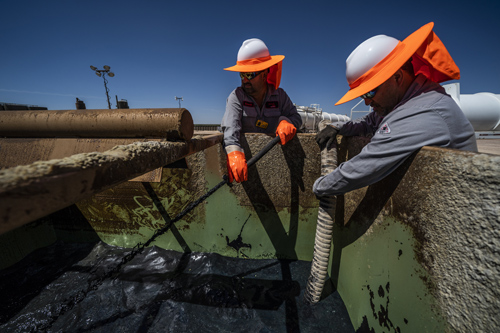
Doer Rite货车运输公司的工人在石油公司走后进行清理。

快餐车主查克·弗拉切为石油工人提供服务。
|
按照和石油公司签的矿物租赁协议,后者将把石油开采收入的四分之一分给布伦森和他的一大家子人。他们的农场上有大约50口油井,规模和井龄各不相同。按每桶约70美元的价格计算,其中最赚钱的油井每年能给布伦森一家带来的税前特许权使用费高达380万美元。这还只是石油。与石油一同开采出来的天然气和其他烃类还会产生额外的特许权使用费。另外,钻井公司安装输油管道等基础设施要经布伦森一家同意,并向他们缴纳手续费。 对布伦森来说,这笔意外之财的数量有点儿诡异,而且让他觉得有些难堪。布伦森平常开着GMC皮卡,以差不多100年前在这里放牛的爷爷为偶像,当他开车穿过农场,看到租用土地的石油公司把这里搞的一团糟时,还会像牛仔一样说脏话。布伦森说,这笔钱“超过了我们的需要。我们不知道拿它怎么办,而它却不停地来。”73岁的布伦森戴着眼镜,很消瘦,他的白色山羊胡让人想起肯德基老爷爷,他的口才则会让人联想到幽默大师威尔·罗杰斯。 布伦森表示:“我们可不打算变得超乎想象的富有。但看来事情一定会变成这样。” 确实,当石油行业出现历史上数得着的大发展而命运又把你的农场放在风口上时,想不发大财都难。布伦森的农场位于二叠纪盆地核心地带,这个富含石油的盆地横跨得州西部和新墨西哥州东南部,面积比北达科他州还大。二叠纪盆地的石油产量正处于“井喷”状态,就算按得州最高的标准衡量也是如此。在美国这片炎热的土地上,石油行业的繁荣改变了生活的方方面面,有好的变化,也有坏的,而且在全球各地都能听到它的回响。 |
Under the terms of the mineral leases they’ve signed with oil companies, Brunson and his extended family receive one-quarter of the revenue from every barrel the drilling companies pull up. The Brunsons have about 50 wells on the ranch, of various sizes and ages. With oil trading around $70 per barrel, among the most prolific of those wells could generate as much as $3.8 million per year in royalties before taxes for the Brunsons. And that’s just for the oil. The Brunsons earn additional royalties from the sale of the natural gas and other hydrocarbons that come up with the oil. And they earn fees from the drilling companies for permission to install infrastructure such as pipelines. The size of this unexpected windfall is a bit bizarre and more than a little embarrassing to Brunson, who drives a GMC pickup, idolizes a grandfather who rustled cattle here nearly 100 years back, and curses like a cowboy—“goddamn it!”—when he drives across his ranch and sees what he regards as messy operations by the oil companies leasing his land. The money “is more than we need. We don’t know what to do with it. But it keeps coming,” says Brunson, a lanky, bespectacled 73-year-old, who evokes Colonel Sanders with his silver goatee and Will Rogers with his silver tongue. “We have no inclination to be rich beyond our wildest dreams,” he adds. “Apparently, it’s going to happen anyway.” Indeed, it’s hard not to rack up wealth when fate puts your ranch at the epicenter of one of the biggest oil booms in history. Brunson’s land sits in the bull’s-eye of the Permian Basin, a ¬petroleum-rich swath of western Texas and southeastern New Mexico—bigger than North Dakota—that is experiencing a gusher of production growth epic even by the outsize standards of the Lone Star State. The boom is remaking every aspect of life in this parched part of the country, for good and for ill. And it is reverberating across the globe. |

|
二叠纪盆地的横空出世正在改变能源地缘政治格局。今年5月,该盆地石油日产量飙升至320万桶。受此推动,今年2月美国整体石油日产量突破1020万桶。美国能源信息署的数据显示,这是1920年联邦政府开始记录相关数字以来的最高水平,甚至超过了1970年11月1000万桶的高点。据市场数据公司Baker Hughes介绍,今年4月在二叠纪盆地作业的钻机平均数量为449台,占当月美国作业钻机的44%,全球的22%。该公司的数据表明,过去两年在二叠纪盆地作业的钻机数量增加了两倍以上。一年来油价大幅上升让钻机作业变得更为急迫。 有人把二叠纪盆地的石油资源和沙特的加瓦尔油田相提并论——外界广泛认为加瓦尔油田是所有超大型油藏,也就是业界所说的“大象级”油田所在地。埃克森美孚旗下XTO能源公司(XTO Energy)总裁萨拉·奥特韦恩说,二叠纪盆地“资源量巨大,而且将对全世界产生影响”。埃克森美孚在今年的《财富》美国500强名单中位列第二。它已经是二叠纪盆地的最大石油生产商之一,而且计划到2025年将在该盆地的产量提高两倍。美国西方石油公司(Occidental Petroleum)在今年的《财富》美国500强名单排在第220位,也是在二叠纪盆地加倍下注的主要石油公司之一。该公司首席执行官薇姬·霍勒布也表示,这个地区是“世界上最好的盆地之一”。 让石油公司高层垂涎不已的是此前100年的生产对二叠纪盆地来说或许仅仅是个开始。 1923年,米德兰德东南部一口名为Santa Rita一号的油井打出了石油,从那时起,人们就知道二叠纪盆地是个大油田,那口井现在也成了传奇。地面上散布的采油机是一代代石油人在这里钻探的绝佳证据。地质学家估算,该盆地现有的逾40万口油井已经开采了大约300亿桶石油。而行业分析公司Wood Mackenzie认为,仍留存在地下的,或者用行话来说,“可采储量”是这个数字的2-3倍。 让二叠纪盆地如此有吸引力的原因在于它是一个巨大的浅盆地。在数百万年时间里,动物的死亡和腐烂以及沉积物的堆垒造就了无数含油岩层,特别是页岩。石油人把岩层称为油层单元,它就像一个石头般坚硬的煎饼,里面充满了烃类“糖浆”,等待着人们去开采和销售。就这些“煎饼”的数量及其厚度来说,二叠纪盆地可谓无可匹敌。 “市场目前正在热炒。每个人都想在二叠纪盆地占据一席之地。” ——阿米尔·格尔斯:壳牌二叠纪地区总经理 石油行业无法用页岩油赚钱的情况曾延续了几十年——那时石油公司只能在其他较容易开采的岩层构造中生产石油。要想弄清楚其中的原因,大家首先要明白,地下油藏并不是在巨大的池子里;相反,它存在于岩石的细小孔洞中,就像海绵中的水。最容易开采的岩层孔隙度要高(也就是说有大孔),渗透性还要好(孔洞相互连接的很好)。页岩的这两项指标往往都很低。用行话来说就是,它是致密岩层,石油实际上被封在了里面。 随后,压裂技术革命改变了游戏规则。大概10年前,新技术让致密页岩采油对石油公司来说有了性价比。其要点在于结合横向钻井,从而使每口油井都覆盖一大片区域,然后用工业规模的液体压裂使致密岩石破碎。石油公司最初把这些技术用于规模较小的页岩层,原因是采掘难度较小。比如北达科他州、蒙大拿州和加拿大的巴肯构造以及南得州的伊格福特。二叠纪盆地的构造更为复杂,但石油储量也大得多。现在,石油工人已经掌握了这里的地质情况,这个盆地的石油产量开始“井喷”。 |
The emergence of the Permian is changing the geopolitics of energy. Oil production in the Permian soared to 3.2 million barrels per day in May. And it helped push total U.S. production above 10.2 million barrels per day in February. That was the highest that U.S. production has been since the federal government began keeping records in 1920—higher even than the prior peak of 10 million barrels per day in November 1970, according to the U.S. Energy Information Administration (EIA). In April, an average of 449 rigs were drilling holes in the Permian, according to market-data firm Baker Hughes. That was 44% of all the rigs drilling that month in the U.S. And it was 22% of all the rigs drilling in the world. Over the past two years, Baker Hughes figures show, the number of rigs drilling in the Permian has more than tripled. A surge in the price of oil over the past year has only added to the urgency of the drillers piling in. Some compare the Permian’s buried treasure to that of Saudi Arabia’s Ghawar field, widely regarded as the mother of all giant petroleum troves—what the industry calls “elephants.” The Permian is “a huge resource, and it will play out globally,” says Sara Ortwein, president of the XTO Energy unit of Exxon Mobil, No. 2 on this year’s Fortune 500, which already is one of the Permian’s biggest producers and plans to triple its output here by 2025. Adds Vicki Hollub, CEO of Occidental Petroleum, No. 220 on the 500 this year, and another major Permian player that’s doubling down in the region: The region is among “the best basins of the world.” What has oil executives salivating is that the Permian, as it finishes its first century of production, may just be getting started. Ever since 1923, when a now legendary oil well southeast of Midland called the Santa Rita No. 1 struck black gold, the Permian Basin has been known as a big one. The pump jacks dotting the landscape are iconic evidence that generations of oilmen have drilled this turf. Geologists estimate that the existing wells—more than 400,000 so far—have pulled up about 30 billion barrels of oil. Yet industry analysis firm Wood Mackenzie estimates two or three times that amount of oil remains underground, and “recoverable,” in industry terms. What makes the Permian so alluring is that it’s a massive geologic platter. Over millions of years, the death and decay of critters and the buildup of sediment has produced countless layers of oily rock—in particular, shale. Oilmen call each layer a “pay”—a rock-hard pancake full of hydrocarbon syrup just waiting to be tapped and sold. In the number of these pancakes and in their thickness, the Permian may well be unparalleled. “There is hype in the market now. Everybody’s trying to build a position in the Permian.” ——Amir Gerges: Royal Dutch Shell’s General Manager for the Permian Region For decades, the oil industry was unable to profitably pull much oil from shale—only from other, easier-to-tap, rock formations. Understanding why requires realizing that buried oil doesn’t exist in vast pools; rather, it sits, as if in a sponge, inside tiny holes in rocks. The rocks that are easiest to tap have both high porosity (meaning: big holes) and high permeability (holes that connect well to each other). Shale tends to have both low porosity and low permeability. It is, in the lingo, tight. Which used to mean the oil was essentially trapped. Then the fracking revolution changed the game. About a decade ago, new technology made it cost-effective for oil companies to drill in tight shale. The trick was to combine horizontal drilling, enabling each well to fan out across a wide area, with industrial-scale hydraulic fracturing, or fracking, to crack up the innards of tight rock. Initially, the industry deployed these techniques in lesser shale plays such as the Bakken formation—in North Dakota, Montana, and Canada—and in the Eagle Ford, in South Texas, because they were simpler to drill. The Permian is a more complex area, but it’s also vastly richer with oil. Now that the drillers have mastered its geology, the basin’s production has begun to explode. |
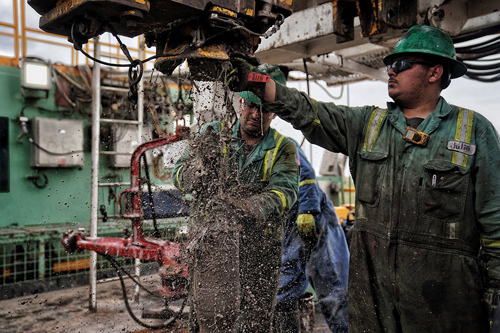
|
Wood Mackenzie预计,今后10年,二叠纪盆地将占美国新增石油产量的三分之二,全球新增石油产量的四分之一。该公司首席分析师西蒙·弗洛尔斯认为二叠纪盆地对全球的影响和北海类似,后者在大约40年前开启了大规模深水钻井时代。弗洛尔斯说:“二叠纪盆地的规模与之相当。” 由于存在大量油层单元,再加上已经遍布石油生产基础设施,二叠纪盆地提升全球石油产量的成本甚至有可能低于一些传统上一直主导石油行业的地区,比如俄罗斯和中东。弗洛尔斯指出,二叠纪盆地有相当多的地点“都处于最佳油藏甜点上”。石油公司表示,在这些地点开采的石油可在国际油价低于每桶30美元的情况下实现正回报——这要远低于其他一些地区。弗洛尔斯称,这给俄罗斯和欧佩克出了个难题:“午餐被二叠纪盆地抢了以后我该怎么办?” 简而言之,二叠纪盆地为“回到未来”的能源体系打开了一扇窗户,这个未来从基本面上讲将非常像100年前石油时代的发端。这些年来,大型石油公司在沙特、俄罗斯和西非等一系列偏远地区开疆扩土。现在,这些公司又迫不及待地要进入西得州沙漠,而这里实际上正是它们的诞生地。 在二叠纪盆地,石油行业蓬勃发展而带来的影响随处可见,而且其中许多并非有利影响。虽然富人赚了钱,但穷人却难以承担不断攀升的物价,从食杂到住房都是如此。这场繁荣还给基础设施带来了压力,有时是很危险的压力。当地道路过窄,交通事故死亡人数因此上升。输油管道不足,买家不得不用卡车运走很大一部分石油,从而加剧了交通堵塞并造成了更多污染。同时,土地本身也因地震和塌陷洞而“战栗不已”。 二叠纪盆地的枢纽是米德兰德,一座人口约15万的城市。它建立于19世纪80年代,最初其实是一座车站,或者说是太平洋铁路沃斯堡-埃尔帕索段的中点。1923年Santa Rita一号井让人们发财致富后,米德兰德的历史就一直随着油价上下波动。市中心的建筑反映了石油行业繁荣期的几波建设活动。最经典的建筑当属市中心的石油大厦(Petroleum Building),这座华丽的12层大楼竣工于1929年,比经济和油价崩盘早了几个月。 吉姆·亨利可能是米德兰德石油人的典范。1969年,三十四、五岁的亨利创立了亨利石油公司(Henry Petroleum)。2008年,他以6亿美元的价格将公司转让。我在他的米德兰德办公室跟83岁的亨利见面时,他对我说:“6亿美元”,目的是保证我听清楚了这个数字。亨利的办公桌上放着一本紫红色封面的圣经参考书《上帝对你一切所需的应许》(God’s Promises for Your Every Need);他和布什一家的照片挂在墙上——这个总统家庭曾经住在米德兰德;他还有一架里尔私人飞机停在机场。亨利戴着金丝眼镜,有浓密的白色头发,他的大脑则是一本百科全书,里面的知识都和这片让他发家致富的土地有关。 亨利的石油公司最初开采的油层单元名叫Spraberry,在米德兰德地下约9000英尺(约2743米)。采矿权租赁成本大概是每英亩(4,047平方米)300美元,钻一口垂直井要花费15万美元左右。2008年亨利把自己的公司套了现,将其转让给了当地竞争对手Concho Resources。如今,Spraberry在米德兰德周边的采矿权租赁费高达每英亩4万美元,像亨利那样钻出水平井并压裂的成本约为每口800万美元。 二叠纪盆地的现代化石油生产是一条砂砾多但成熟的户外流水线。和非洲或亚洲海域的深水盆地不同,在这里人们的目标并不是真的要发现油藏,因为在西得州的这个区域,油田早就已经发现了。人们在二叠纪盆地的目标更像是普通劳动者——把油藏最丰富的地段集中在手里,然后执行钻井和压裂计划,从而以最低成本开采出石油。 就像硅谷软件工程师捋顺代码来改善app性能那样,二叠纪盆地的石油工程师用计算机记录的当地地质情况来调整生产过程的方方面面,进而从石头缝里榨出更多石油。他们决定着在每一平方英里土地,也就是一个开采区里打多少眼井,以及在什么的深度、相隔多远为这些油井钻出水平井——后者的长度一般为2英里(3.23公里)。他们还决定着从美国各地的矿山究竟购买多少专门加工的沙土以及这些沙土的粒度。这些沙土将和差不多数百万加仑水混合,而且经常要加入某些化学品,从而制成要注入油井的压裂液。 现代化钻机一般都有几层楼高,钻头由一名操作员控制,后者坐在被称为“狗屋”的小亭子里,看着一排电脑屏幕并用摇杆来引导钻头。钻一口井往往需要大约三周时间,然后钻机就会靠四只巨大的“铁脚”站起来,走到下一个要钻井的位置,移动速度大概是每两分钟一英尺。 J. 克雷格·科比特在Henry Resources勘探部门当了10年的主管,去年秋天才退休。他说:“找到这个秘诀花了很长时间和大量资金。”科比特的家在米德兰德一条叫Charismatic Drive的路上,这是一片高档社区,有一家电影院、一座木质装潢的两层图书馆和一个车库,除了几部能发出低沉轰鸣的车辆外,这里还停着两辆速度特别快的保时捷。科比特说:“我过的挺好。” 数说二叠纪盆地 449台 4月在二叠纪盆地作业的钻机数量,占美国所有作业中钻机的44%,全球的22%。 320万桶 5月二叠纪盆地石油日产量。该盆地的采油热推动美国石油日产量达到1020万桶的历史最高点。 6000-9000万桶 二叠纪盆地的“可采”石油储量。 来源:Baker Hughes、美国能源信息署、Wood Mackenzie 如今亨利的公司只是二叠纪盆地的一家小公司。这是因为那些大家伙纷纷入驻此地。几十年前,许多大型跨国石油公司都曾在这里采油,20世纪90年代和21世纪头10年里,它们来来去去,但都相信深水油田的产油量远高于这片沙漠。科比特回忆说,那时许多石油公司高管都把二叠纪盆地称为“永远的地下室”——意思是让职业生涯走进死胡同的荒芜沙漠。 压裂技术创新颠覆了这种观点。今天,超大型石油公司赌的是它们能把在别的页岩构造上测试过的大规模企业效率带到二叠纪盆地,进而将这里的大量石油开采出来,而且在成本和利润方面的表现会好于亨利这样的分散“个体户”。 埃克森美孚就是这些巨头之一。它在二叠纪盆地的作业面积为180万英亩(7284.6平方公里),比特拉华州还大。这里面有25万英亩是2017年1月埃克森美孚从得州巴斯家族企业手中收购而来。油田交易数据提供商PLS Inc.的信息显示,此项交易的价格为56亿美元头期款加上10亿美元的潜在追加付款,对应的每英亩价格为2万美元。 埃克森美孚的全球日产量约为400万桶油当量,其中4%左右来自二叠纪盆地。该公司计划到2025年将二叠纪盆地的产量提高两倍。XTO能源总裁奥特韦恩说,埃克森美孚在该盆地开发和运营油井的成本低于每桶15美元,在该公司的全球页岩油业务中处于“低端”。 在二叠纪盆地,石油公司担心的主要问题是石油产量超过了输油管道向市场输送原油的能力。因此,它们的客户不得不用卡车把所购石油中的很大一部分运走,或者把自己的石油放在这里,直到有可用的输油管道。这两种方案都会提高成本。所以,买家向二叠纪盆地石油公司支付的价格一直比主流市场价低10美元,业内人士把这个差额称为“盆地价差”。 |
Over the next decade, the Permian will account for two-thirds of the increase in total U.S. oil production and one-quarter of the increase in total global oil production, projects Wood Mackenzie. Simon Flowers, Wood Mackenzie’s chief analyst, likens the global impact of the Permian to that of North Sea, which ushered in the era of large-scale deepwater drilling some 40 years ago. “The Permian,” he says, “is of that scale.” Because of its stack of pays and because it already has extensive oil-producing infrastructure in place, the Permian could be a cheaper place to boost global oil production than even some of the spots that traditionally have dominated the oil industry—places such as Russia and Middle East. There are quite a lot of locations in the Permian, “in the best of the sweet spot,” says Flowers, where companies are reporting that they can produce oil with favorable returns at a global oil price lower than $30 per barrel—significantly less expensively than in some other parts of the world. That, says Flowers, raises a discomfiting question for Russia and OPEC: “What do I do when the Permian is eating my lunch?” The Permian, in short, is a window onto an energy system that’s heading back to the future—to a time that, in fundamental ways, looks a lot like the start of the Oil Age a century ago. Over the years, Big Oil has buzzed over a succession of faraway frontiers: Saudi Arabia, Russia, West Africa. Now it’s agog anew about the place where it effectively was born: the West Texas desert. On the ground in the Permian, the impacts of the boom are visible everywhere, and many of them aren’t good. Though the haves are cashing in, the have-nots are having trouble affording rising prices for everything from groceries to housing. The boom also is straining infrastructure, sometimes dangerously. Local roads are too narrow, boosting traffic deaths. Pipelines are inadequate, forcing buyers to truck out much of the oil, which is worsening gridlock and increasing pollution. Meanwhile, the ground itself is convulsing in earthquakes and sinkholes. The Permian’s hub is Midland, a city of about 150,000 people. It was founded in the 1880s essentially as a way station—the midway point on the Texas and Pacific Railway between Fort Worth and El Paso. Ever since the 1923 Santa Rita bonanza, Midland’s history has tracked the ups and downs of oil. The downtown architecture reflects waves of construction during periods when oil boomed. The most iconic structure remains downtown’s Petroleum Building, an ornate 12-story tower that was finished in 1929, months before the economy and oil prices crashed. Jim Henry may be Midland’s paradigmatic oilman. In 1969, in his mid-thirties, he started Henry Petroleum. In 2008, he sold it for $600 million. “Point-six billion,” Henry, now 83, tells me when I visit him in his Midland office, making sure I get the number right. He keeps a maroon book of biblical references, God’s Promises for Your Every Need, on his desk; photos of his friends the Bushes, the presidential family that once lived in Midland, on a wall; and a Learjet at the airport. In his head, framed by wire-rimmed glasses and thick white hair, he keeps an encyclopedic knowledge of the land that has made him rich. When Henry began producing oil, in a stack pay called the Spraberry about 9,000 feet below Midland, leasing mineral rights cost perhaps $300 an acre and drilling a vertical well cost about $150,000. After Henry cashed out in 2008, selling to ¬Concho Resources, a local rival, he took half the money he banked in the deal and founded a new oil company, Henry Resources. Today, leasing the mineral rights in the Spraberry around Midland can cost as much as $40,000 an acre, and the horizontal wells Henry drills and fracks cost about $8 million each. Modern oil production in the Permian resembles a gritty but sophisticated open-air assembly line. Unlike in, say, deepwater basins off Africa or Asia, the goal in the Permian isn’t so much to find the oil, because the oil here in West Texas long ago was found. The goal here is more workmanlike: to assemble the acreage that contains the most oil and to execute the drilling and fracking plan that will pull it out at the lowest cost. Just as software engineers in Silicon Valley massage code to improve apps, petroleum engineers in the Permian use computerized profiles of the local geology to tweak everything about the production process and wring more oil from the rock. They decide how many wells to cram into each one-square-mile patch of land, called a “section”; at what depth and what distance from each other to drill the horizontal extensions of those wells, which typically run for two miles; and the precise amount and granularity of the specially engineered sand they buy from mines around the U.S. to mix into the million or so gallons of water that, often with certain chemicals, they use to make the fracking fluid they shoot down into a well. A typical modern rig is several stories tall, its drill bit controlled by an operator who, sitting in a booth called a “doghouse,” monitors a bank of computer screens and guides it with a joystick. When the rig finishes drilling one well, a process that often takes about three weeks, it stands up on its four monstrous steel feet and walks, one foot about every two minutes, to the spot where it will drill the next one. “It’s taken a long time and a lot of capital to figure out the recipe,” says J. Craig Corbett, who headed exploration at Henry Resources for a decade until he retired last fall. His house, on an upscale street in Midland called Charismatic Drive, has a movie theater, a two-story wood-paneled library, and garage that holds, among several other throaty conveyances, two particularly fast Porsches. “I’ve done okay,” he allows. THE PERMIAN BASIN BY THE NUMBERS 449 Number of oil rigs drilling in the Permian in April. That was 44% of all rigs drilling in the U.S. and 22% of the number worldwide. 3.2 million Barrels per day of oil produced in the Permian in May. The Permian boom has helped push U.S. production to a record 10.2 million barrels per day. 60 to 90 billion Barrels of “recoverable” oil remaining underground in the Permian region. SOURCES: Baker Hughes; U.S. E.I.A.; Wood Mackenzie Henry today is but a small player in the Permian. That’s because the big boys are piling in. Many of the multinational oil giants were here a generation ago but pulled out or pulled back in the 1990s or 2000s, convinced the deep water would be far more productive than this desert. Back then, Corbett recalls, the Permian Basin was known among many oil executives as the “Permanent Basement”—the godforsaken spot in the sand where careers went to die. The innovations in fracking upended that view. Today, oil’s “super majors” are betting they can bring to bear the large-scale corporate efficiencies they have been testing in shale plays elsewhere to squeeze out the Permian’s vast quantities of oil more cheaply and profitably than can scrappy independents like Henry. One of the biggest is Exxon Mobil. It has a position of 1.8 million Permian acres, an area larger than Delaware. That includes about 250,000 Permian acres to which Exxon bought access in January 2017 from companies owned by the Bass family of Texas. The deal, valued at $5.6 billion up-front with a potential additional payment of $1 billion, implied a per-acre price of $20,000, according to PLS Inc., a provider of data about oilfield transactions. Globally, Exxon produces about 4 million barrels of oil equivalent per day. It produces about 4% of that in the Permian, and it plans to triple its Permian production by 2025. Its cost to develop and operate wells in the Permian is below $15 per barrel—on the “low range” of Exxon’s costs to develop shale plays around the world, says Ortwein, the XTO unit’s president. A major concern for Permian producers is that oil production in the basin has outstripped the capacity of pipelines to get it to market. Customers thus have to transport much of the oil they buy via truck, or let their oil sit until room opens up on today’s pipelines. Both options can inflate costs. As a result, the buyers have been paying Permian producers as much as $10 less per barrel than the prevailing market price—the “basin differential,” as insiders call the gap. |

|
西方石油CEO霍勒布说:“这是个问题,下一条输油管道建成前这个问题将一直存在,而下一条管道计划到2019年才能投入运营。”该公司在二叠纪盆地的作业面积为140万英亩,仅略少于埃克森美孚。西方石油称之为“非常规”业务,实际上就是页岩油。该公司打算利用输油管道紧张的问题为自己谋利。霍勒布说西方石油的管道运能足以输送自己生产的石油,而且还可以通过收费方式为其他公司输送原油。“我们的情况非常理想,不光能输送自己的石油,还可以通过为第三方输送石油来赚钱。” 壳牌(Royal Dutch Shell)也在二叠纪盆地采油。2000年壳牌曾弃此地而去,2012年再次进入这个地区。它在这里的作业面积约为26.5万英亩,远小于埃克森美孚和西方石油。但壳牌二叠纪盆地总经理阿米尔·格尔斯表示,他们拥有“整个岩层中厚度最大的一块儿”。 和大多数进入二叠纪盆地的石油公司一样,壳牌正忙于和别的石油公司交换采区(每个采区的边长为四分之一英里),目的是让两个采区连成一片。它需要连续的采区,以便钻出关键的两英里长的水平井。壳牌喜欢在每个采区打4-8口井,但格尔斯指出,其他公司“更为大胆”,一个采区最多能打16口井。尽量榨取单位面积利润很重要,但这在很大程度上是因为地价已经如此之高。格尔斯说:“现在市场正在热炒,每个人都想在二叠纪盆地占据一席之地。” 我在二叠纪盆地兜了几天,所到之处都是石油繁荣的迹象——从四处散落的桔红色火焰中就能感受到,它们发出喷气式发动机一样的轰鸣,并且照亮了夜空。这些火焰来自同石油一起升腾至地面的天然气。和输油管道一样,二叠纪盆地的天然气管道目前供给不足。由于天然气价格低,获得得州监管部门允许的石油公司会在规定期限内点燃天然气,这是它们争相尽量提高石油产量的措施之一。 Oilfield Fishing and Rental是米德兰德一家石油生产设备维修和租赁公司,场地有飞机库大小,我在这里感受到了石油行业的蓬勃发展。该公司首席机械师达雷尔·韦德尔戴着绘有联邦旗和火焰图案的头巾,正在修理一台动力输出装置。石油工人经常把这种拖在卡车后面的沉重金属设备作为油田里各种泵的动力源。韦德尔一边大放滚石乐队的《It’s Only Rock’n’ Roll》,一边给我打了比方:“我们比踢屁股比赛上的独腿选手还要忙。” 2017年行业概况:能源 收入:1.4万亿美元 利润:850亿美元 员工人数: 827,529 股东总回报率*:5.1%* *股东总回报率采用2007-2017年年均水平。 一天晚上,我在米德兰德的Hawthorn Suites酒店和30岁的前台接待V. J.·辛格聊天时同样体会到了这场繁荣。辛格两年前随妻子从孟买搬到了米德兰德,当时他的妻子已经在这里的酒店找到了工作。辛格说,2017年初堪堪可用的酒店房间每晚价格为100美元。现在,在生意最好的时候,这种房间的价格一般为300-800美元,有时甚至更高。4月的一个深夜,辛格告诉我,两位急于寻找落脚之地的客人按现价入住了酒店的最后两间空房,每间1000美元。 这样的繁荣景象触动了我,有它好的一面也有坏的一面。时近傍晚,我在20号州际公路米德兰德入口匝道旁的Kwik Chek加油站停车,想喝杯冷饮。石油工人从油田走来,加油站变得热闹起来。 24岁的扎克·埃克霍特站在柜台外面。他是一名拖车司机,大概六个月前从内布拉斯加州来到米德兰德。他工作时间很长,每个月平均能挣1万美元。埃克霍特说:“有时候我不知道拿这些钱怎么办,除了瞎买点儿东西”,比如160多美元一条的Rock Revival牛仔裤。他回忆道:“上星期我在购物中心花了3000美元。”他的信用卡额度只有1500美元,所以他不得不打电话给信用卡公司,“暂时提了额度”。 柜台里面站的是萧娜·卢埃林,39岁的她一直住在米德兰德,有两个孩子。她每周在Kwik Chek加油站最多工作35个小时,时薪12美元。为了养家糊口,她还为别人打扫房间和房车,一般每周至少六次,每次150美元。卢埃林说,许多房子都由石油工人租住,他们的衣服得用力刷洗。“你得学会多耍滑头。所有的东西都变得非常快。”她带着这样的思绪说,“真的很快。” “我们比踢屁股比赛上的独腿选手还要忙。” ——Oilfield Fishing and Rental首席机械师达雷尔·韦德尔 如果说石油行业的繁荣在米德兰德显而易见,那它就让米德兰德西南约95英里(153公里)的佩科斯彻底变了样。佩科斯的官方人口数量为8780人,但当地官员说实际人口可能比这个数字高50%。作为二叠纪盆地西侧主要城镇,佩科斯位于这个盆地烃类储量特别丰富的地区,被称为特拉华盆地,它从里弗斯县(首府为佩科斯)向北跨越拉夫灵县(格里尔·布伦森的农场所在地),然后延伸至新墨西哥州东南部。Baker Hughes的数据显示,截至5月中期,在里弗斯县作业的钻机有66台,超过了美国其他县。米德兰德县有44台钻机,位居第二。 佩科斯在历史上一直默默无名。据说它有世界上最古老的牛仔竞技表演。这座小镇的主要地标是West of the Pecos博物馆,这幢齐整的砂石建筑前并列着两座雕塑——一对颜色鲜亮的8英尺高牛仔靴。 佩斯科及其周边地区再也不会昏昏欲睡了。如今,镇上到处都是“男人营地”——政府官员估计,这种匆忙建起的宿舍在整个里弗斯县可能容纳了几千名石油工人。佩斯科的Dairy Queen已经连续六年成为得州汉堡销量最高的Dairy Queen店面,2017年的准确销量为149897个。佩斯科的几个公路路口都新建了卡车停车场,日出时人们在加油点相互搭讪,晚上油田工人会去买咖啡和冰镇啤酒,此时的停车场热闹非凡。 通常,佩斯科建起新的工人宿舍区或卡车停车场后,当地负责人维尼塔·西尔斯都会去剪彩。我在当地医院和她见了面——她是医院的社区关系主管。对于镇上的繁荣景象,西尔斯说:“这是一把双刃剑。”她的办公室内墙粉刷用了两种紫色;在一面墙上悬挂着小镇的推广海报,上面写着:“这不是我们的第一届牛仔竞技表演。” 西尔斯认为,好的一面是纳税人群不断扩大,愿意努力工作而且掌握钻井技能的人都可以拿到六位数的薪水。而坏的一面是,垃圾成堆,总有学生转到别的学校,另外,装着压裂用沙土的火车定期从中西部抵达佩科斯车站的巨大卸货区,这些火车一共挂着140节车厢,它们会在镇中心的铁路交叉口造成拥堵。同时,还有很多18轮大卡车堵在那里,继而排放出大量柴油烟尘。 所有这些卡车都装着沙土,另外还有几千辆运载着水、石油、管道、泵、油罐和其他油田需要的所有东西——它们把二叠纪盆地的道路变成了事故多发地。美国第285号公路,这条贯穿特拉华盆地核心地带的双向两车道公路随着半挂车驶入和驶出通向油井的砂石路而持续处于“窒息”状态。 当地人把285号公路称为“死亡之路”。截至5月中期,里弗斯县和拉夫灵县发生的14起致命交通事故中,有8起发生在这条路上。得州公共安全部佩科斯分局负责人罗伯特·奥尔警长表示:“油田改变了我们周围的一切。”他还说,在这14起致命事故中,有12起和油田有关。他叹息说,在油田车辆司机中,有人吸毒,有人过劳,有人为了多挣一单的钱而超速。 |
“It is a problem, and it’s going to be a problem until the next pipeline is built, which is not scheduled to come online until 2019,” says Hollub, Occidental’s CEO. Oxy, which has a position of 1.4 million acres of what it calls “unconventional”—essentially, shale—production in the Permian, only slightly less than Exxon Mobil, is angling to exploit the pipeline crunch to its own advantage. Hollub says Oxy has more than enough pipeline capacity to transport what it produces and to charge others to transport some of theirs. “We’re very well suited not only to get our production out but also to get third-party production out and make money on it.” Royal Dutch Shell also is pouncing in the Permian, which it abandoned in 2000 and then reentered in 2012. Its Permian position is far smaller than Exxon Mobil’s and Oxy’s—Shell has a position of about 265,000 acres. But, contends Amir Gerges, Shell’s general manager for the Permian, it’s in “the thickest part of the formation.” Shell, like most Permian players, is busy swapping one-square-mile sections of land with other oil companies to assemble holdings of two sections apiece. It needs those contiguous sections to drill the crucial two-mile-long horizontal wells. Shell likes to drill between four and eight wells per section, but, notes Gerges, other companies are “more aggressive,” poking as many as 16 wells into a given square mile. Squeezing every dollar from every acre is crucial in large part because land prices have risen so high. “There is hype in the market now,” he says. “Everybody is trying to build a position in the Permian.” Traveling around the Permian for a few days, I’m confronted by evidence of the boom everywhere. I hear and see it in the orange flames that dot the landscape, roaring like jet engines and lighting up the night sky. These are flares of the natural gas that comes up from the ground along with the oil. Natural-gas pipelines, just like oil pipelines, are insufficient in today’s Permian; with gas prices low, oil producers are, with permission from Texas regulators, burning gas for specified periods as part of the race to maximize the output of oil. I feel the boom when I stop in at Oilfield Fishing and Rental, a hangar-size shop in Midland that fixes and rents oil-production equipment. Darrell Weddle, wearing a head wrap that bears a Confederate flag and a flame, is repairing a “power take-off,” a heavy metal device that oil workers often hook to a truck to power a pump in the field. With the Rolling Stones’ “It’s Only Rock’n’ Roll” blasting, Weddle, the head mechanic, tells it like it is: “We’re busier than a one-legged man in a butt-kicking contest.” 2017 Sector Profile: Energy Revenues:1.4 Trillion Profits:$ $85 Billion Employees:827,529 Total return to shareholders:5.1%* *Total Return to Shareholders assumes the 2007–2017 Annual Rate. I sense the boom when, after a night at Midland’s Hawthorn Suites hotel, I chat with V.J. Singh, the 30-year-old front-desk clerk. He moved to Midland two years ago from Mumbai following his wife, who already had gotten a hotel job in town. In early 2017, a room in the hotel, which is best described as serviceable, went for about $100 a night, he says. Now, in the middle of the week, when business is brisk, that room typically fetches between $300 and $800—and sometimes even more. Late one night in April, Singh tells me, two men desperate for a place to sleep paid the going rate for the hotel’s last two open rooms: $1,000 apiece. And I’m struck by the boom—both sides of it—when I stop for a cold drink at a Kwik Chek gas station by an on-ramp to Interstate 20 in Midland. It’s late afternoon. Oil workers are coming in from the fields. The place is hopping. On the customer side of the counter is Zach Eeckhout, 24, a tow-truck driver who moved to Midland from Nebraska about six months ago. He works long hours, and he takes home, on average, $10,000 per month. “I don’t know what to do with it sometimes,” he says, “other than spend it on stupid stuff,” such as Rock Revival jeans, which sell for upwards of $160 a pair. “Last week I went to the mall and spent $3,000,” he recalls. His credit card had a $1,500 limit, so he had to phone the card company and “up it for the day.” On the employee side of the counter is Shawna Lewellen, who has lived in Midland for all of her 39 years. The mother of two works up to 35 hours a week at the Kwik Chek, for $12 an hour. To make ends meet, she also cleans houses and RVs, typically at least six per week, for $150 apiece. Many of the homes are rented by oilfield workers, whose clothing, she notes, requires intense scrubbing. “You learn to juggle a lot out here. Everything’s really fast,” she says, lingering on the thought. “It’s really fast.” “We’re busier than a one-legged man in a butt-kicking contest.” ——Darrell Weddle: Head Mechanic at Oilfield Fishing and Rental If the boom is palpable in Midland, it is utterly remaking Pecos, about 95 miles to the southwest. Officially, Pecos’s population is 8,780; in fact, officials say, it’s probably 50% more than that. Pecos (pronounced PAY-cuss) is the main town on the Permian’s western flank, perched atop a particularly hydrocarbon-rich portion of the Permian known as the Delaware Basin. The Delaware extends from Reeves County, of which Pecos is the seat, north to Loving County, where Grier Brunson’s ranch sits, and then up into southeastern New Mexico. As of mid-May, according to Baker Hughes, 66 rigs were operating in Reeves County—more than in any other county in the nation. Midland County, with 49 active rigs, was No. 2. Pecos historically has been a sleepy place. It claims to be the site of the world’s oldest rodeo. Its chief landmark is the West of the Pecos Museum, a trim sandstone building in front of which stand twin sculptures: brightly painted, 8-foot-tall cowboy boots. Pecos and its surroundings are sleepy no more. Today the town bursts with “man camps”—hastily built encampments of dormitories, that, throughout Reeves County, probably house several thousand oilfield workers, officials estimate. Pecos’s Dairy Queen has sold more hamburgers than any other in Texas for six years running—exactly 149,897 in 2017. New truck stops anchor Pecos’s handful of highway intersections; they pulse at sunup with pickups at the pumps and at night with roughnecks buying Monster caffeine drinks and cold beer. Typically, when a new man camp or truck stop opens in Pecos, the town’s mayor, Venetta Seals, shows up to cut the ribbon. “It’s a double-edged sword,” she says of the boom when I meet her at the local hospital, where she works as director of community relations. Her office is painted in two tones of purple; on one wall hangs a promotional poster from the town that reads, “This ain’t our first rodeo.” On the upside, she notes, the tax base is bulging, and six-figure salaries are available to anyone who wants to work hard and can drive a big rig. On the downside, the dumpsters are overflowing, the school district is experiencing a constant churn of students, and 140-car trains carrying fracking sand regularly arrive from the Midwest at a massive unloading yard in Pecos, halting traffic at the railroad crossing in the center of town. Much of the gridlock consists of 18-wheelers that, as they idle, spew diesel soot. All those trucks carrying sand—and thousands more carrying water, oil, pipe, pumps, tanks, and everything else an oilfield needs—are turning Permian roads into graveyards. U.S. 285, a two-lane road that runs through the heart of the Delaware Basin, chokes at all hours with semis turning into and out of the gravel paths that access the wells. Dubbed by locals “Death Highway,” 285 was the site of eight of the 14 auto-related fatalities that, as of mid-May, had occurred this year in Reeves and Loving counties. “The oilfield changed everything for us,” says Robert Orr, the Texas Department of Public Safety sergeant who heads the Pecos office, adding that 12 of the 14 deaths were oilfield-related. He laments oilfield workers behind the wheel who are using drugs, who are overworked and tired, or who are driving too fast as they race to deliver another paying load. |
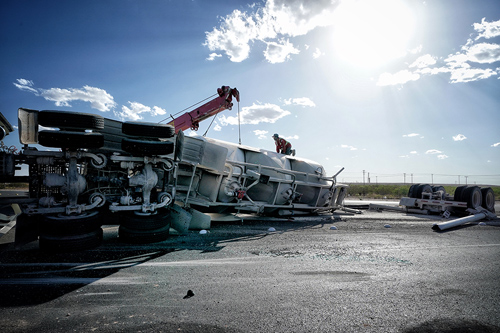
|
其他威胁来自土地本身。当地居民,尤其是佩斯科周边的居民表示该地区经常发生地震。西尔斯说,3月的“每个星期四都地震了”,可以感觉到震动。佩斯科经济开发公司(Pecos Economic Development Corporation)执行董事小肯尼斯·温克斯和妻子住在离西尔斯家六个街区远的地方。当温克斯开着他的雪佛兰Suburban带我和西尔斯在镇上兜圈时,他告诉我前一天晚上自己刚冲完淋浴,妻子就冲他喊道:“你感觉到了吗?刚刚又晃了。”她的意思是地震。 二叠纪盆地的某些地区不光有地震,还有地陷。位于佩斯科东北的温克镇自称为“石油和友谊构筑的城镇”。几十年来,它最出名的一点是乡村摇滚歌手罗伊·欧比森曾经的家乡。现在温克镇开始因为地陷而为人所知。早在1980年,镇上就出现了一个特别深的塌陷坑。另一处则不是真的地陷,而是小镇东北部201号县公路路面上一系列不详的弯折痕迹。 南卫理公会大学地球物理学教授卢仲(音译,Lu Zhong)所在的科学团队正在用卫星图像来研究二叠纪盆地各处的地面沉降现象,该团队认为这是一个危险信号。卢仲认为,油气井破裂后逐步渗出的水溶解了地下盐层,导致地面下沉,而某些地点最终会发生塌陷。他警告说,石油公司需要更好地维护老化油井,以免渗漏。卢仲对我说:“我们不打算指责谁。大家都在享受石油和天然气带来的繁荣。但我们可以利用一些技术来改善这些油井的健康状况。” 当我告诉他我打算去看看201号县公路出现“褶皱”的那段路时,他给了我一些建议:“我可不会把车停在那儿。”他还告诫我说,那条路随时都可能“塌陷”。 2017年的最新统计数据显示,在拉夫灵县,也就是格里尔·布伦森的农场所在地,每5英里(8.5公里)才有一个人。该县正式居民有134人,是美国人口第二少的县,仅次于卡拉沃县。后者位于夏威夷州,是一座银色小岛,19世纪曾作为麻风病人定居点。人口稀少往往会放大二叠纪盆地居民的巨大收益。 布伦森24岁的儿子埃文及其妻子泰勒住在米德兰德郊区的一所房子里。一天晚上,我在这所房子的后院遇到了布伦森。布伦森把自家农场上新钻出的三口油井命名为泰勒1号、泰勒2号和泰勒3号。泰勒则给我倒了一杯卡伯纳沙维翁红酒。这瓶酒来自南非一家酿酒厂,其所有者是布伦森家族某位成员的朋友。 |
Other dangers are coming from the ground itself. Residents, particularly around Pecos, report periodic earthquakes. In March, “it happened every Thursday,” says Mayor Seals, who says she felt the tremors. Kenneth Winkles Jr., executive director of the Pecos Economic Development Corporation, lives with his wife six blocks from Seals. As he, Seals, and I drive around Pecos in his Chevy Suburban, he tells me that the prior night, after he got out of the shower, his wife shouted to him: “Did you feel it? We just had another boom.” She meant the seismic sort. In some places in the Permian, the ground isn’t merely shaking, it’s caving in. Wink, a Permian town northeast of Pecos, calls itself “The City That Oil & Friendship Built.” For decades it was known mainly as the onetime home of Roy Orbison, the rockabilly crooner. Now Wink also is gaining fame for its sinkholes. One especially deep one developed as far back as 1980. Another isn’t yet a true sinkhole; it’s a series of ominous ripples in the asphalt on County Road 201, northeast of town. Zhong Lu, a geophysics professor at Southern Methodist University in Dallas, is part of a scientific team that has used satellite imagery to study what it regards as alarming land subsidence throughout the Permian. Over time, he believes, water from decaying oil-and-gas-related wells has leaked, dissolving subterranean salt layers and causing the ground to shift and ultimately, in places, to cave in. He warns that the industry needs to better shore up its aging wells against leaks. “We’re not trying to point fingers,” he tells me. “Everybody is enjoying the prosperity of oil and gas. But there’s technology we can use to modify the health of these wells.” When I mention to Lu that I’m planning to visit the cracking section of County Road 201, he offers some advice: “I wouldn’t park my car there.” At any time, he warns, the road might “collapse.” Loving County, where Grier Brunson’s ranch sits, has just one resident for every five miles, according to the latest count, in 2017. With 134 official residents, Loving is officially the second-least-populous county in the nation, behind Kalawao County, Hawaii, a tiny sliver of land that was set aside in the 1800s as a colony for people with leprosy. The emptiness of the landscape in the Permian tends to magnify the outsize benefits accruing to its beneficiaries. One night I meet Brunson in the backyard of the suburban Midland house where his 24-year-old son, Evan, and Evan’s wife, Taylor, live. Taylor, for whom the Brunsons have named three of the newest wells on the Loving County ranch—Taylor 1, Taylor 2, and Taylor 3—pours me a glass of Cabernet Sauvignon from a South African winery owned by friends of a member of the extended Brunson family. |
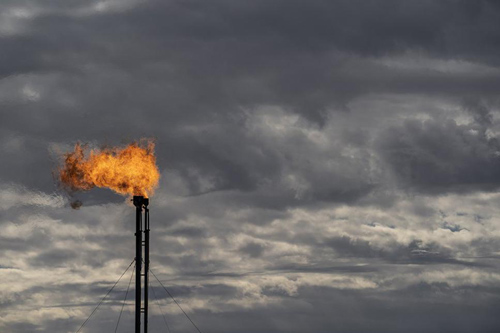
|
坐在躺椅上的布伦森开始给我讲故事。有些跟他的祖父有关,“他在大萧条、两次世界大战以及黑风暴事件中都一直苦苦经营着三个农场。那都是很艰难的日子”。另一个故事是1980年他们家农场上的一口油井发生了爆炸,油井燃起大火,因此得到了“布伦森焚烧者”的绰号。负责油井运营的是盖蒂石油公司(Getty Oil),创始人是石油行业传奇J. 保罗·格蒂。他有一句名言:“谦卑人必承受地土,而非其中的矿产权。”布伦森说:“这是我的准则。” 对于眼下规模空前的石油钻井活动,布伦森很矛盾。出于这个原因,他整天都追着那些租下他们家采矿权的石油公司不放——他固执地强迫后者履行合同,尽量减少在地上留下的“疮疤”。布伦森说:“我真的哭过,因为我亲眼见到了人们对得克萨斯的伤害,而目的只是为了把地下的自然资源弄出来。” 就在他说话的同时,他们家农场上那片绿地周围的钻机依然在这个深夜,在西得州黑色的天空下运转着。除非地理学家、投资者和来自世界各地的石油公司都大错特错了,否则二叠纪盆地这颗明星在今后几年里依然会继续升起。(财富中文网) 本文最初刊登在2018年6月1日出版的《财富》杂志上。 译者:Charlie 审校:夏林 |
Brunson, sitting in a lawn chair, starts telling stories. Some are about his grandfather, “who husbanded these ranches through the Depression, two world wars, and the Dust Bowl. Those were hard times.” One is about a well on the family ranch that exploded in 1980, burning stupendously and earning the moniker the Brunson Burner. The operator of that well was Getty Oil, whose founder, the legendary oilman J. Paul Getty, had a famous line: “The meek shall inherit the earth, but not its mineral rights.” Says Brunson, “That’s my mantra.” But Brunson is conflicted about the unprecedented drilling going on today. That’s why he spends his days bird-dogging the oil companies to which his family has leased its mineral rights: He’s hell-bent on forcing them to honor their contracts and minimize the scars they leave on his land. “I have been literally crying because I have seen the damage done to Texas in my lifetime just to get natural resources out of this ground,” he says. As he speaks, late at night under a dark West Texas sky, the drilling rigs that ring the grassy draw on his ranch are still cranking. Unless geologists, investors, and oil companies from around the planet are dead wrong, the Permian’s star will be rising for years to come. This article originally appeared in the June 1, 2018 issue of Fortune. |













